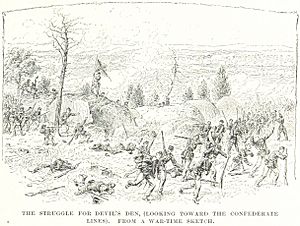Devil's Den facts for kids
Quick facts for kids Devil's Den |
|||||||
|---|---|---|---|---|---|---|---|
| Part of the Gettysburg Campaign | |||||||
 The struggle for Devil's Den during the battle |
|||||||
|
|||||||
| Belligerents | |||||||
| Commanders and leaders | |||||||
| Brig. Gen. J.H. Hobart Ward (w) | |||||||
| Strength | |||||||
|
6 Infantry regiments |
5,525 total | ||||||
| Casualties and losses | |||||||
|
138 killed |
329 killed |
||||||
Devil's Den is a famous rocky hill at the Gettysburg Battlefield in Pennsylvania. It's covered with huge boulders. During the American Civil War, soldiers used this spot. It was especially important on the second day of the Battle of Gettysburg in 1863. Today, Devil's Den is a popular place for visitors. You can see cannons, memorials, and even a bridge between the rocks.
Contents
History of Devil's Den
Devil's Den was formed a very long time ago, about 200 million years. It was created by natural forces like freezing and thawing. This process broke apart a type of rock called igneous rock. This rock had pushed up from deep inside the Earth. Devil's Den is connected to other famous spots like Little Round Top and Big Round Top.
How Devil's Den Got Its Name
This rocky area got its spooky name before the 1863 battle. Local people in the mid-1800s believed a very large snake lived in the cracks between the boulders. Stories said the snake was anywhere from 8 to 15 feet long! People called this snake "The Devil." Because of this, the place where the snake supposedly lived became known as "The Devil's Den." Some soldiers even called it "Devil's Cave." There's also a spot on a rock that collects water and looks like a flying bat with horns.
Devil's Den in the Battle of Gettysburg
On July 2, 1863, Devil's Den became a key battleground. Union soldiers from Smith's battery used the hill. They fired their cannons at Confederate artillery. This happened before a major attack by Confederate General McLaws.
Defending Devil's Den
Later that day, Confederate General Hood's soldiers attacked. Devil's Den was defended by Union General Birney's division. It was the far left side of the Union's III Corps. The hill was eventually captured by the Confederate 1st Texas Infantry. They pushed forward and took the Union cannons. After this, Confederate soldiers used Devil's Den to launch their next attack on The Wheatfield.
Sharpshooters and Counter-Fire
Confederate sharpshooters hid among the rocks at Devil's Den. They fired at Union soldiers on nearby Little Round Top. Two important Union officers, General Stephen H. Weed and Lieutenant Charles E. Hazlett, were hit by these sharpshooters. Hazlett's cannons fired back at Devil's Den. The force of the cannon fire killed many of the sharpshooters hiding in the rocks.
Images for kids
-
Civil War artist Alfred Waud sketching for the Battle of Gettysburg at Devil's Den.
-
Devil's Den (left) is across Sickles Av & Plum Run from the trolley railbed.






